The e-commerce industry is incessantly evolving; today, players are improving and customizing their businesses to meet customers where they are. The industry has overcome the notion where “pricing & product were kings,” Today, quality experience and instant support decide the winner.
E-commerce customer service practices are ever-evolving; often led by new technologies, these trends keep changing year after year. Yet, even with evolving trends, quality customer experience continues to be of umpteen importance.
Brands like Puma are leveraging Augmented Reality to help customers visualize the product better. Similarly, Amazon is repeatedly harvesting customer data to deliver intelligent product recommendations. When these prodigal technologies and methodologies are leveraged for customer service, the entire game changes for the better.
Today, we will take you through a list of dominating e-commerce customer service trends. We will also be touching base with customer service improvement ideas.
Table of Contents
Explained: Customer Service in E-commerce
E-commerce customer service is primarily about helping customers with:
- Finding resolution related to a product
- Raising return request
- Identifying products that fit their requirements
- Collecting information about their refunds
E-commerce players are investing in customer service trends and innovations because it:
- Reduces customer churn
- Improves customers’ decision-making capabilities
- It helps customers enjoy the shopping experience
- Allows sellers to interact with customers and minimize return requests
- Stops customers from panicking and filing a return request
Lack of effective e-commerce customer service will:
- Lead to a maligned reputation
- 84% of customers never coming back after just one bad experience
- Return requests skyrocketing
- Poor product discovery
- Lost opportunities of up-selling
Think Remote: E-commerce Customer Service from Home
Until 2019, the omnichannel support and self-help section were among the top priorities of e-commerce organizations. In 2021, businesses are looking forward to building a remote customer service system that remains active through thick and thin. Here’s how having a small strategy works in favor of e-commerce players:
Emergency Response System: With the COVID outbreak, e-commerce players were left vulnerable. They failed to deliver products on time, ensure proper communication to end-users, and also had a tough time compensating sellers for effects lost in transit.
With an emergency response system, players can effectively:
- Communicate with end-users and stop them from canceling orders
- Keep logistics players in the loop and ensure the safety of products
- Help sellers locate their products and managing impending payments
- Leverage a hotline for all communication related to the pandemic or a disaster
- Use a BCP for customer service to ensure minimum disruption
Remote Compliance Management: With an unprecedented rise in remote work, government and industry bodies have come together to revisit the existing regulations. With more relaxed norms, organizations will hire the best support executives and let them work remotely.
Compliance with remote regulations will enable e-commerce platforms to:
- Improve overall customer support by hiring exceptional talent
- Reduce expenditure on every FTE and use it for customer service innovation
- Keep their customer support running irrespective of pandemic or disasters
E-commerce Customer Service Best Practices
A recent study highlights, 81% of Americans believe that top organizations are exceeding customer service expectations. Another reputed study suggests that 40% of Americans believe businesses have improved their focus on customer service in the recent past.
Well, the uptrend in customer service is quite tangible now. With all organizations investing in customer service improvement and innovation, those who aren’t are likely to be left behind.
On the contrary, organizations establish relations among customers, sellers, and catalog and product management to offer incomparable customer support. The increased dependency on catalog management and seller involvement for servicing customers is a great sign.
Let’s learn more about popular e-commerce customer service trends:
1. Make Self-Help A Priority
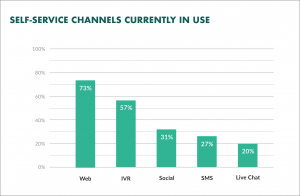
With over 40% of users preferring self-service over human contact, businesses need to pivot fast. Over 70% of users prefer using the company’s website instead of social media for support. The website can access the self-help section better, which ensures instant access to quality information.
Here’s how e-commerce players should bank upon this customer service trend:
Build a self-help section: E-commerce platforms help customers make an informed decision through effectively created catalogs. These catalogs are designed to improve decision-making, inclusive of the product description, quality images, and UGC. Similarly, organizations can prepare a self-help section, where nuanced information like “how to use,” “how to install,” or “how to service” is available. One such area will allow users to solve their innocuous problems instantly.
Allow customers to get in touch with sellers: Not all problems can be solved by returning a product; many challenges can be overcome simply by getting in touch with sellers. For example, often, customers face challenges with imported products, which need assistance. Sellers can quickly help customers identify the right way to operate a product, minimize return requests, and uphold a quality customer service experience.
Amazon allows customers to get in touch with sellers and also access all predefined messages/information left by sellers for a particular product.
Leverage User-Generated-Content for Education: Amazon has allowed users to post Video Feedback on products in recent development. Customers are now showcasing how the product looks and works in real life. Why is it a revolutionary move?
- UGC helps other customers see the product instead of visualizing it
- UGC ensures that the product shown on site is being delivered
- Helps e-commerce platforms minimize return or replacement requests
2. Act on Customer Feedback
While the best form of customer service is self-service, listening to customers and optimizing customer support pays heavy dividends. Organizations can turn their customers into a chief source of learning and identify service areas that need improvement. Here’s how it helps:
Helps improve customer experience: 43% of participants agreed to help organizations improve customer support by sharing feedback. Customers want to continue with one store for as long as possible. By listening to their input and optimizing processes, e-commerce players can offer quality support and reduce churn.
A study on the importance of customer feedback shows, 76% of consumers expect businesses to understand their needs and expectations.
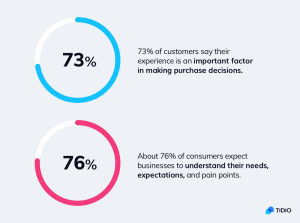
Assists with word-of-mouth marketing: Customers love sharing experiences; no matter if it’s a good experience or a bad one, people discuss it with their peers. When you listen to customers, take their feedback seriously and introduce new elements of customer service, end-users are likely to brag about it on social media and other channels. These words travel faster than highly optimized Facebook Ads. The reach of word of mouth is incomparable because everyone wants to come across as someone with influence.
Brings in referral business: Consumers discuss experiences and pain points among themselves. Customers with satisfactory experiences are likely to tell their friends to use your service or products. For e-commerce platforms with exceptional customer support, finding customers is not a challenge; existing ones will likely keep bringing in referral sales.
A study states that 90% of all buying decisions rely on peer recommendations, which explains why listening to customer feedback and implementing changes can help in the long run.
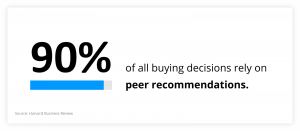
3. Improve Average Response Time
According to Freshdesk, the average response time on call and chat is close to 3hrs, which is not impressive. However, some e-commerce organizations have mastered the art of instant response by leveraging omnichannel architecture. So let’s dive deeper and discover how e-commerce platforms can reduce average response time.
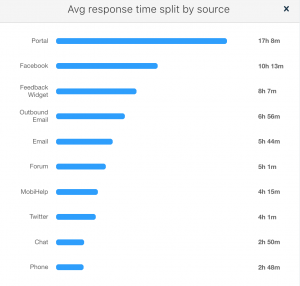
Implement Live Chat Right Away: Food aggregators like Uber Eats and Zomato leverage Live chat to offer real-time support. For example, the chat feature allows users to register a complaint, seek updates, and receive refunds.
Live chat can do wonders for e-commerce players; it can:
- Help customers raise a complaint
- Allow users to seek product recommendation
- Provide users with an update about their previous orders
- Ensure a smooth decision-making experience for users
Social Media: It is tough to reach out to millions of users about an update. An Oberlo study says there are over 3.78 billion daily active users across social media platforms like Facebook, Instagram, Twitter, and more.
Social media allows e-commerce platforms to reach out to millions of customers at once. One broadcast message and everyone knows about a mishap on your website. Similarly, online stores can collate all requests raised on social media and file them in the system using bots and AI.
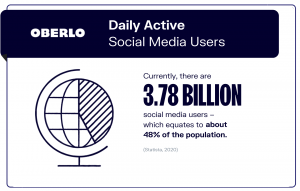
Leverage a Ticketing System: A ticketing system is essential because:
- It helps with creating an omnichannel architecture
- It allows agents to view all the past requests in one place
- Ensures easier data management
- Simplifies update modules and allows all stakeholders to view the status
Some top ticketing systems are equipped with additional capabilities that can highlight all kinds of challenges and opportunities. For example, E-commerce players can choose from one of these ticketing systems:
Kayako: A ticketing software capable enough to collect information and present them in an illustrated format. Leverage this unique tool to start building your omnichannel system. With Kayako placed at the core of your customer service infrastructure, agents can fill cases, and stakeholders can check updates with great ease.
ClickDesk: Unlike another ticketing system, Clickdesk is equipped with a live chat feature. This two-in-one tool allows e-commerce portals to serve customers and also file their complaints. Tools like these are pushing e-commerce players to get more done in less time. The device comes with a free version, which can support businesses during their initial phase. It is a must-try tool, and it simplifies the overall management of customer grievances.
5. Build an Exceptional E-commerce Customer Support Team
Groove suggests 55% of customers get into business with a company because of its excellent customer service. With so much riding on customer service, investing in an exceptional customer support team makes sense.
Here’s a defined roadmap:
How to build an impactful customer support team?
To build a strong customer service team, an organization needs to set a tone first. Once the motto/mission statement is identified, it gets easier to hire like-minded people and train them.
Hire & Train: Start looking for people with prior experience in offering quality customer support. Once you have identified the right set of people for your team, start training them. Providing training about your business process, common grievances, and how to resolve a situation will set them up for handling the harshest customers with ease.
Equip with Latest Technology: As mentioned earlier, contact center technologies are changing customer experience. With omnichannel expertise taking center stage, organizations’ dependence on technology is increasing rapidly. Get a ticketing system in place, follow MK’s omnichannel framework and integrate all channels using a CRM to offer an exceptional experience.
Measure Performance At regular Intervals: The key to continuously improve customer service lies in revisiting the processes and strengthening them. Focusing on varied contact center metrics is a good way of measuring performance.

E-commerce Customer Service Improvement Ideas
Nascent e-commerce players that are in the initial stages and are focused on crafting a customer service paradigm can follow the steps above. Likewise, traditional and existing players with a loyal audience can improve their offerings by leveraging these ideas.
1. Offer Omnichannel Expertise
Omnichannel expertise is now a key differentiator. Customers want to access the same content and support across all platforms irrespective of the location or device they are using. At MattsenKumar, we are constantly helping e-commerce players, online gaming platforms, and NBFCs develop omnichannel expertise to offer better customer service.
Offering omnichannel expertise helps with:
- Reducing Customer Effort Score
- Improves Net Promoter Score
- Increasing referral sales
- Improves marketing activities
- Allows customers to browse easily throughout the website
2. Live Chat to Help with Decision Making
We have emphasized enough on implementing Live Chat for improving customer experience. Live chat not only makes navigation easy but also offers quick access to all crucial links. One can rely on this exceptional feature to help customers have a pleasant browsing experience while getting the work done.
Some of the most underrated benefits of live chat are:
Reduces chances of product returns: By helping customers find products resembling the most by their query, live chat helps in reducing “return requests” because wrong products were delivered.
Improves customer experience: Gets the work done quicker and allows users to get back to their lives within minutes—no need to browse through the entire site looking for relevant products or a particular section. Instead, ping the Live Chat and get it done.
Helps make informed decisions: Well-optimized live chat helps people make an informed decision by displaying more than one product. In addition, they can use “relevant product” tags to showcase the most popular products that resemble the queries made by the user.
3. Personalize your Email Campaigns
Email continues to be a marketing tool of great value. While the CTR on social media platforms is dropping, the open rate of well-targeted emails is increasing. As a result, more and more people are identifying email as a strict mode of communication, and businesses relying on it are benefiting a lot.
Here’s how to personalize email for improved customer service:
Offer Option to connect with support agents: Allow users to connect instantly with an agent through email. Since email has all the information related to products and complaints, e-commerce players can offer the omnichannel experience to the user.
Use the opportunity to up-sell when offering support: Well, customer support is an excellent way of pitching high-value products. Your customer ran into a problem? Help them get over with a new product. A considerable percentage of customers pay for unused products if treated well and offered correction suggestions.
Allow customers to submit feedback: Well, until a few years ago, support email addresses looked like noreply@abc.com; these email accounts were not prepared for receiving a response or feedback. Today, organizations allow customers to reply to their newsletter, support emails, and marketing materials. It makes it easier for both customers and organizations to understand the context of the conversation, leading to improved customer service and exceptional customer experience.
Final Thoughts on E-commerce Customer Service
There’s no alternative for quality customer service; with CX becoming a key differentiator, organizations are bound to improve customer service. With outsourcing services, e-commerce platforms can equip themselves with industrial expertise and build an exceptional customer service infrastructure.
At MattsenKumar, we work in close ties with leading marketplaces and standalone e-commerce portals. Our industrial expertise helps them streamline catalog management, product management, seller management, and support services to improve customer experience.

